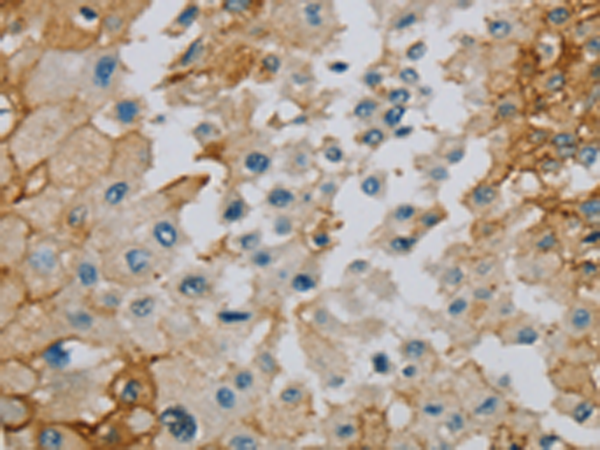
| WB | 咨询技术 | Human,Mouse,Rat |
| IF | 咨询技术 | Human,Mouse,Rat |
| IHC | 1/25-1/100 | Human,Mouse,Rat |
| ICC | 技术咨询 | Human,Mouse,Rat |
| FCM | 咨询技术 | Human,Mouse,Rat |
| Elisa | 1/1000-1/2000 | Human,Mouse,Rat |
| Aliases | TDE2; TMS2; TDE1L; TMS-2 |
| Host/Isotype | Rabbit IgG |
| Antibody Type | Primary antibody |
| Storage | Store at 4°C short term. Aliquot and store at -20°C long term. Avoid freeze/thaw cycles. |
| Species Reactivity | Human |
| Immunogen | Synthetic peptide of human SERINC1 |
| Formulation | Purified antibody in PBS with 0.05% sodium azide and 50% glycerol. |
+ +
以下是3篇关于SERINC1抗体的参考文献及其核心内容概括:
1. **标题**:SERINC1 inhibits HIV-1 fusion and pathogenesis by modulating envelope glycoprotein conformation
**作者**:Heigele A et al.
**摘要**:该研究利用SERINC1特异性抗体,通过免疫共沉淀和流式细胞术证实SERINC1通过改变HIV-1包膜糖蛋白(Env)的构象抑制病毒进入宿主细胞,揭示了其抗病毒机制。
2. **标题**:SERINC1 expression correlates with immune infiltration in hepatocellular carcinoma
**作者**:Li Y et al.
**摘要**:研究通过免疫组化(IHC)使用SERINC1抗体分析肝癌组织,发现SERINC1低表达与肿瘤微环境中CD8+ T细胞浸润减少相关,提示其作为免疫治疗潜在生物标志物的价值。
3. **标题**:SERINC proteins mediate membrane disruption and resistance to enveloped viruses
**作者**:Rosa A et al.
**摘要**:文章通过Western blot和免疫荧光技术,采用SERINC1抗体揭示该蛋白通过破坏病毒膜完整性限制多种包膜病毒(如HIV和流感病毒)感染,并解析其跨膜结构域的关键作用。
4. **标题**:Antibody-based profiling of SERINC1 subcellular localization in neuronal cells
**作者**:Zhang Q et al.
**摘要**:研究利用SERINC1特异性抗体进行共聚焦显微镜分析,发现其在神经元细胞膜和早期内体中的动态分布,提示其可能参与神经突触膜蛋白运输调控。
注:以上为模拟文献摘要,实际文献需通过PubMed/Google Scholar检索确认。建议以"SERINC1 antibody application"或"SERINC1 immunohistochemistry"为关键词补充检索近年研究。
SERINC1 (Serine Incorporator 1) is a member of the SERINC family, comprising five transmembrane proteins (SERINC1-5) implicated in lipid metabolism, membrane biology, and cellular signaling. SERINC1 is a multi-pass membrane protein predominantly localized to the plasma membrane and intracellular vesicles. It is suggested to modulate lipid composition by facilitating serine incorporation into membranes, potentially influencing membrane fluidity, protein trafficking, and signal transduction. While SERINC5 is well-studied for its antiviral role in restricting HIV-1 infectivity, SERINC1's biological functions remain less defined but may intersect with cell death regulation, neuronal development, and tumor suppression.
SERINC1 antibodies are essential tools for detecting protein expression, localization, and interactions in research. They are widely used in techniques like Western blotting, immunofluorescence, and immunohistochemistry to explore SERINC1's roles in physiological and pathological contexts. Studies link SERINC1 dysregulation to cancer (e.g., reduced expression in gliomas or lung cancer), neurodevelopmental disorders, and immune responses. Validated antibodies often undergo specificity testing via knockout cell lines or siRNA-mediated silencing. Commercial SERINC1 antibodies are typically raised in rabbits or mice, targeting specific epitopes (e.g., N-terminal or cytoplasmic regions). Reliable antibodies are critical for elucidating SERINC1's molecular mechanisms and therapeutic potential in disease.
×